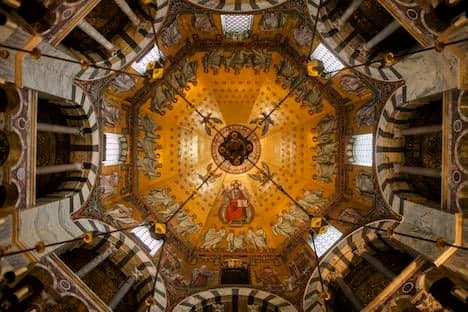Aachen Cathedral

As the summer holidays approach, The Local is touring Germany's UNESCO World Heritage Sites. To kick things off, we visit Aachen's Imperial Cathedral.
In 786 AD Charlemagne dreamed of creating a "new Rome" when he ordered the construction of the Church of St. Mary and its Palatinate chapel in his main residence of Aachen. He thus laid the foundations for one of the most important buildings in Europe, making the city the focal point of his Roman empire in 800 AD.
The cathedral is of universal importance in terms of art and cultural history. 30 German kings were crowned there over a period of 600 years (936-1531), and the cathedral treasury is one of the finest in Europe. It houses sacred treasures from the late Classical, Carolingian, Ottonian, Hohenstaufen and Gothic eras, some of which are among the most important artworks of their time. Since the Middle Ages, Aachen Cathedral has been one of the leading pilgrimage sites in the Christian world because of its famous reliquaries - the four holy shrines.
Charlemagne was buried in the palatinate chapel following his death in 814. His ancient sarcophagus can be found in the central drum of the Gothic chancel. The cathedral is the town's most famous landmark and its appearance has been shaped over the course of more than a thousand years. It has been a UNESCO-World Heritage since 1978.
Comments
See Also
In 786 AD Charlemagne dreamed of creating a "new Rome" when he ordered the construction of the Church of St. Mary and its Palatinate chapel in his main residence of Aachen. He thus laid the foundations for one of the most important buildings in Europe, making the city the focal point of his Roman empire in 800 AD.
The cathedral is of universal importance in terms of art and cultural history. 30 German kings were crowned there over a period of 600 years (936-1531), and the cathedral treasury is one of the finest in Europe. It houses sacred treasures from the late Classical, Carolingian, Ottonian, Hohenstaufen and Gothic eras, some of which are among the most important artworks of their time. Since the Middle Ages, Aachen Cathedral has been one of the leading pilgrimage sites in the Christian world because of its famous reliquaries - the four holy shrines.
Charlemagne was buried in the palatinate chapel following his death in 814. His ancient sarcophagus can be found in the central drum of the Gothic chancel. The cathedral is the town's most famous landmark and its appearance has been shaped over the course of more than a thousand years. It has been a UNESCO-World Heritage since 1978.
Join the conversation in our comments section below. Share your own views and experience and if you have a question or suggestion for our journalists then email us at [email protected].
Please keep comments civil, constructive and on topic – and make sure to read our terms of use before getting involved.
Please log in here to leave a comment.